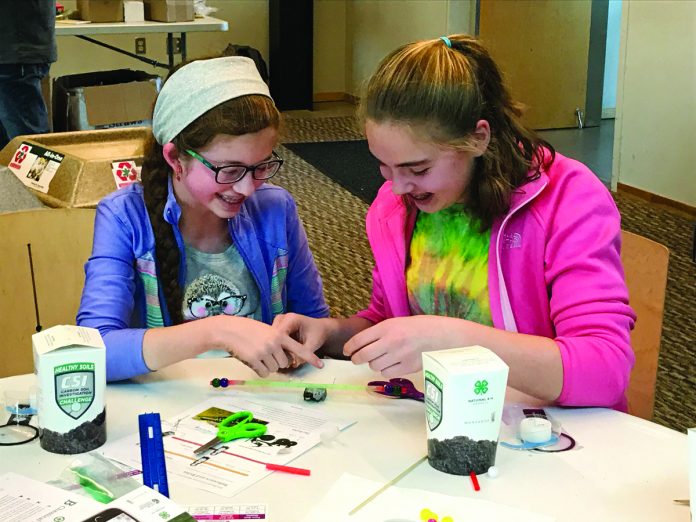
COLUMBUS — Soil sample and testing supplies? Check. Building materials? Check. Hexbug?
What in the world is a hexbug? A hexbug is a microrobot that sixth- and seventh-grade students from Clear Fork Middle School in Morrow County used to complete the 4-H Ag Innovators Experience, the Healthy Soils C.S.I. (Carbon Soil Investigation) Challenge.
Ohio 4-H hosted the 2017 challenge kickoff in April at the Nationwide and Ohio Farm Bureau 4-H Center on the Ohio State University campus in Columbus. By the end of December, several thousand other students from Ohio, Michigan, Missouri, Illinois and Nebraska will have used a hexbug microrobot to complete the Healthy Soils C.S.I. Challenge, too.
The 4-H Ag Innovators Experience, sponsored by Monsanto Co. and the National 4-H Council, is designed for youth to learn about environmental and sustainability issues important to agriculture through hands-on activities, according to the 4-H Ag Innovators Experience website.
Different topics
Ohio 4-H has been the lead state for this program for the past four years, with the topic changing each year.
“The motivation to starting the Ag Innovators program was to generate interest in agricultural careers among youth,” said Patty House, a 4-H educator based in OSU Extension’s Clark County office. “Universities are not graduating enough students for the growing number of available agricultural careers.”
This program focuses on a sustainable agriculture premise that would allow future agriculturalists to feed a billion more people. Helping with the event were 4-H members Koleson McCoy, Abigail Myers and Evan Callicoat, each one a high school student from Clark County, who were chosen by House to attend the Ag Innovators Experience training in Washington, D.C., in February.
Clark County 4-H alumnus and no-till farmer Andrew Armstrong also helped with the event as a farming specialist.
McCoy, Myers, Callicoat and Armstrong will be helping lead future Healthy Soils C.S.I. Challenges in Ohio over the course of this year. According to Callicoat, students go home from the challenge with a better understanding of STEM (science, technology, engineering and math) skills, such as the engineering design process and scientific testing.
The Healthy Soils Challenge consists of two parts: Part one includes student teams conducting various tests on a soil sample to determine if the soil is healthy, a practice many farmers do annually. Part two challenges teams to engineer a new and better way to plant crops while minimizing soil disturbance.
Teams are given the materials to design, build and test their own small-scale no-till planter that mimics the opening and closing process of no-till planters while minimizing equipment drag and reducing soil compaction.
“We want to inspire kids to be creators of innovation and technology, not just users,” House said. “Many kids are very tech-savvy, but they are just using what others have created. We want to encourage kids to create their own things.”
Program outreach
Each year, land-grant universities submit proposals for a challenge, and the winner’s proposal becomes the 4-H Ag Innovators Experience Challenge. This is the fourth consecutive year Ohio State’s proposal has been selected.
Bob Horton, Ohio 4-H STEM education specialist, along with House, were the creators of this year’s Ag Innovators Challenge. Horton and House have worked with this program the past four years. “Soils was chosen as this year’s topic because soil is where it all begins,” said Bill Bowers, one of the Monsanto representatives in attendance at the kickoff event.
“Monsanto is really interested in soil health and production agriculture, and this program is a great launching pad to involve youth in a growing industry.”
At a second event at the end of April, teens from 12 Ohio counties will come to the Nationwide and Ohio Farm Bureau 4-H Center to learn how to facilitate the Healthy Soils C.S.I. Challenge.
They will take what they learn back to their counties to share with other teen 4-H members and to teach at youth events across Ohio.
Reaching youth
Similar efforts will be undertaken in the five participating states with an estimated 6,000 youth reached overall.
“We hope to reach 1,500 students in Ohio alone,” House said. “This program will engage youth at summer day camps, 4-H camps and after-school programs.
“We want to encourage kids to look at all the career options in the agricultural industry, particularly in STEM areas.”
Outreach for this program will reach far beyond the borders of the United States. A group of FFA students from Ohio will travel to Honduras this summer to teach the Healthy Soils C.S.I. Challenge in vocational schools there.
Adam Staley, FFA educator at Clear Fork High School, is one of the agriscience educators who has taken FFA students to Honduras the past three summers. When FFA students taught the Ag Innovators Experience Challenge there last summer, Staley said, groves of people came to the school to watch.
The 4-H Ag Innovators Experience, Healthy Soils C.S.I. Challenge materials will be available this fall for teachers and youth leaders interested in teaching this activity. The curriculum will also be available at: 4-h.org/get-involved/partners/monsanto/.
Appreciating soils
One of the most critical issues in agriculture, and also an issue that doesn’t get the same amount of attention as something like water quality, is soil health, House said.
“People don’t realize that soil can be the answer to reversing climate change,” she said. “It’s cool to get kids to think about this, especially because it is something that will affect them in their future.”
The Healthy Soils Facilitator Guide provides a detailed overview of the Healthy Soils C.S.I. Challenge.
According to the guide, soil is a mixture of minerals, organic matter, living organisms, air and water — it’s not just dirt.
Soil quality is important because it helps sustain an ecosystem responsible for our food and fiber needs, environmental quality, and human health.
“This becomes extremely important as agriculturalists continue to discuss how to feed the growing world while using good practices to protect the environment,” House said.










